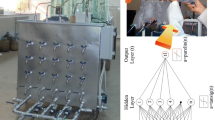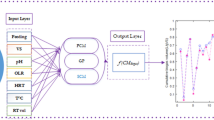Abstract
In this study, experiments were conducted with four different proportions of seed cake of Karanja (SCK) and cattle dung (CD) mixture, for biogas production. 75, 50 and 25 % of the SCK on a mass basis were mixed with 25, 50 and 75 % of the CD and, named as S1, S2 and S3. For comparison, biogas obtained from 100 % CD (S4) was considered. The samples were kept in four different reactors, for 30 days of observation, and the yield of biogas from the samples S1, S2 and S3 was evaluated. Modeling was carried out for prediction and optimization of biogas production using ANN (artificial neural network) and the GA (genetic algorithm). A multi-layered feed-forward network with hidden neurons and linear output neurons was used for training the network using the input parameters pH, digestion time and C/N ratio for the yield of biogas. The performance of the neural network model was verified, and the correlation coefficients were found to be close to 1, for the samples. The experimental results on the biogas production were validated with the results of the neural network and optimized with the GA. The GA optimized values for pH, digestion time, and the C/N ratio of sample S3 were found to be 6.68, 14.22 days and 24.1:1, respectively. These optimized data can be used to monitor a large scale anaerobic plant. Among all samples, S3 gave a better result with respect to the pH, C/N (carbon/nitrogen) ratio, digestion time and biogas yield.










Similar content being viewed by others
Abbreviations
- AI:
-
Artificial intelligence
- ANN:
-
Artificial neural network
- C/N:
-
Carbon/nitrogen ratio
- CD:
-
Cattle dung
- CH4 :
-
Methane
- CI:
-
Compression ignition
- CO2 :
-
Carbon dioxide
- FC:
-
Fixed carbon
- FL:
-
Fuzzy logic
- FTIR:
-
Fourier transform infrared spectroscopy
- GA:
-
Genetic algorithm
- GHG:
-
Greenhouse gases
- H2 :
-
Hydrogen
- H2S:
-
Hydrogen sulfide
- HCCI:
-
Homogeneous charge compression ignition
- MSE:
-
Mean square error
- N2O:
-
Dinitrogen monoxide
- NH3 :
-
Ammonia
- NOx :
-
Oxides of nitrogen
- OLR:
-
Organic loading rate
- PSO:
-
Particle swarm optimization
- R:
-
Correlation coefficient
- RNA:
-
Ribonucleic acid
- RS:
-
Rice straw
- SCK:
-
Seed cake of Karanja
- SI:
-
Spark ignition
- TS:
-
Total solid
- VFAs:
-
Volatile fatty acids
- VOCs:
-
Volatile organic compounds
- VS:
-
Volatile solid
References
Putun, A.E., Uzun, B.B., Apaydin, E., Putun, E.: Bio-oil from olive oil industry wastes: pyrolysis of olive residue under different conditions. Fuel Process. Technol. 87, 25–32 (2005)
Vijay, V.K., Prasad, R., Singh, J.P., Sorayan, V.P.S.: A case for biogas energy application for rural industries in India. Renew. Energy 9, 993–996 (1996)
Phadatare, A.G., Raheman, H.: Diesel engine emissions and performance from blends of karanja methyl ester and diesel. Biomass Bioenergy 27(4), 393–397 (2004)
Yetilmezsoy, K., Sakar, S.: Improvement of COD and color removal from UASB treated poultry manure wastewater using Fenton’s oxidation. J. Hazard. Mater. 151, 547–558 (2008)
Isci, A., Demirer, G.N.: Biogas production potential from cotton wastes. Renew. Energy 32, 750–757 (2007)
Singh, R., Mandal, S.K.: The utilization of non-edible oil cake along with cow dung for methane-enriched biogas production using mixed inoculum. Energy Sources Part A 33, 449–458 (2011)
Yetilmezsoy, K.: A new empirical model for the determination of the required retention time in hindered settling. Fresenius Environ. Bull. 16, 674–684 (2007)
Cakmakci, M.: Adaptive neuro-fuzzy modelling of anaerobic digestion of primary sedimentation sludge. Bioprocess Biosyst. Eng. 30, 349–357 (2007)
Aydinol, F.I.T., Yetilmezsoy, K.: A fuzzy-logic-based model to predict biogas and methane production rates in a pilot-scale mesophilic UASB reactor treating molasses wastewater. J. Hazard. Mater. 182, 460–471 (2010)
Kanat, G., Saral, A.: Estimation of biogas production rate in thermophilic UASB reactor using artificial neural networks. Environ. Model. Assess. 14, 607–614 (2009)
Qdais, H.A., Hani, K.B., Shatnawia, N.: Modeling and optimization of biogas production from a waste digester using artificial neural network and genetic algorithm. Resour. Conserv. Recycl. 54, 359–363 (2010)
Kana, E.B.G., Oloke, J.K., Lateef, A., Adesiyan, M.O.: Modeling and optimization of biogas production on saw dust and other co-substrates using artificial neural network and genetic algorithm. Renew. Energy 46, 276–281 (2012)
Ozkaya, B., Demir, A., Bilgili, M.S.: Neural network prediction model for the methane fraction in biogas from field-scale landfill bioreactors. Environ. Model Softw. 22, 815–822 (2007)
Yetilmezsoy, K., Demirel, S.: Artificial neural network (ANN) approach for modeling of Pb(II) adsorption from aqueous solution by Antep pistachio (Pistacia vera L.). J. Hazard. Mater. 153, 1288–1300 (2008)
Chan, C.W., Huang, G.H.: Artificial intelligence for management and control of pollution minimization and mitigation processes. Eng. Appl. Artif. Intell. 16, 75–90 (2003)
Biyikoglu, A., Akcayol, M.A., Ozdemir, V., Sivrioglu, M.: Temperature prediction in a coal fired boiler with a fixed bed by fuzzy logic based on numerical solution. Energy Convers. Manag. 46, 151–166 (2005)
Altunkaynak, A., Ozger, M., Cakmakci, M.: Fuzzy logic modeling of the dissolved oxygen fluctuations in Golden Horn. Ecol. Model. 189, 436–446 (2005)
Tay, J.H., Zhang, X.: A fast predicting neural fuzzy model for high-rate anaerobic wastewater treatment systems. Water Res. 34, 2849–2860 (2000)
Wichern, M., Gehring, T., Fischer, K., Andrade, D., Lübken, M., Koch, K., et al.: Monofermentation of grass silage under mesophilic conditions: measurements and mathematical modeling with ADM1. Bioresour. Technol. 100, 1675–1681 (2009)
Vijay, K.G., Rintu, B.: Evolutionary and swarm intelligence-based approaches for optimization of lipase extraction from fermented broth. Eng. Life Sci. 10, 265–273 (2010)
Chandra, R., Vijay, V.K., Subbarao, P.M.V., Khura, T.K.: Production of methane from anaerobic digestion of jatropha and pongamia oil cakes. Appl. Energy 93, 148–159 (2012)
Yadvika, S., Sreekrishnan, T.R., Kohli, S., Rana, V.: Enhancement of biogas production from solid substrates using different techniques—a review. Bioresour. Technol. 95, 1–10 (2004)
Weiland, P.: Biogas production: current state and perspectives. Appl. Microbiol. Biotechnol. 85, 849–860 (2010)
Bagi, Z., Acs, N., Balint, B., Hovrath, L., Dobo, K., Perei, K.R., Rakhely, G., Kovacs, K.L.: Biotechnological intensification of biogas production. Appl. Microbiol. Biotechnol. 76, 473–482 (2007)
Ferrer, I., Ponsa, S., Vázquez, F., Font, X.: Increasing biogas production by thermal (70 & #xB0;C) sludge pre-treatment prior to thermophilic anaerobic digestion. Biochem. Eng. J. 42, 186–192 (2008)
Barik, D., Murugan, S.: Investigation on combustion performance and emission characteristics of a DI (direct injection) diesel engine fueled with biogas-diesel in dual fuel mode. Energy 72, 760–771 (2014)
Costa, M.A., Braga, A.P., Menezes, B.R.: Improving generalization of MLPs with sliding mode control and the Levenberg–Marquardt algorithm. Neurocomputing 70, 1342–1347 (2007)
Gen, M.C.: Genetic algorithms and engineering design. Wiley, New York (1997)
Okeh, C.O., Chukwudi, O.O., Frederick, J.C.O.: Biogas production from rice husks generated from various rice mills in Ebonyi State, Nigeria. Renew. Energy 62, 204–208 (2014)
Demirel, B., Scherer, P.: Bio-methanization of energy crops through mono-digestion for continuous production of renewable biogas. Renew. Energy 34, 2940–2945 (2009)
Havukainen, J., Uusitalo, V., Niskanen, A., Kapustina, V., Horttanainen, M.: Evaluation of methods for estimating energy performance of biogas production. Renew. Energy 66, 232–240 (2014)
Martin, A., Borja, R., Garcia, I., Fiestas, J.A.: Kinetics methane production from olive mill waste water. Process Biochem. 26, 101–107 (1991)
Raheman, H., Mondal, S.: Biogas production potential of jatropha seed cake. Biomass Bioenergy 37, 25–30 (2012)
Athanasoulia, E., Melidis, P., Aivasidis, A.: Optimization of biogas production from waste activated sludge through serial digestion. Renew. Energy 47, 147–151 (2012)
Demirbas, A.: Biogas production from the organic fraction of municipal solid waste. Energy Sources Part A 28, 1127–1134 (2006)
Mustafi, N.N., Raine, R.R., Verhelst, S.: Combustion and emissions characteristics of a dual fuel engine operated on alternative gaseous fuels. Fuel 109, 669–678 (2013)
Swami Nathan, S., Mallikarjuna, J.M., Ramesh, A.: An experimental study of the biogas-diesel HCCI mode of engine operation. Energy Convers. Manag. 51, 1347–1353 (2010)
Yoon, S.H., Lee, C.S.: Experimental investigation on the combustion and exhaust emission characteristics of biogas - biodiesel dual-fuel combustion in a CI engine. Fuel Process. Technol. 92, 992–1000 (2011)
Barik, D., Murugan, S.: Simultaneous reduction of NOx and smoke in a dual fuel DI diesel engine. Energy Convers. Manag. 84, 217–226 (2014)
Barik, D., Murugan, S.: Experimental investigation on the behavior of a DI diesel engine fueled with raw biogas-diesel dual fuel at different injection timing. J. Energy Inst. (2015). doi:10.1016/j.joei.2015.03.002
Uusitalo, V., Soukka, R., Horttanainen, M., Niskanen, A., Havukainen, J.: Economics and greenhouse gas balance of biogas use systems in the Finnish transportation sector. Renew. Energy 51, 132–140 (2013)
Gupta, A., Kumar, A., Sharma, S., Vijay, V.K.: Comparative evaluation of raw and detoxified mahua seed cake for biogas production. Appl. Energy 102, 1514–1521 (2013)
Author information
Authors and Affiliations
Corresponding author
Rights and permissions
About this article
Cite this article
Barik, D., Murugan, S. An Artificial Neural Network and Genetic Algorithm Optimized Model for Biogas Production from Co-digestion of Seed Cake of Karanja and Cattle Dung. Waste Biomass Valor 6, 1015–1027 (2015). https://doi.org/10.1007/s12649-015-9392-1
Received:
Accepted:
Published:
Issue Date:
DOI: https://doi.org/10.1007/s12649-015-9392-1




